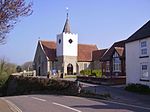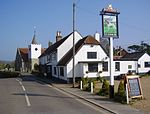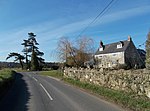Newchurch railway station
Disused railway stations on the Isle of WightFormer Isle of Wight Central Railway stationsPages with no open date in Infobox stationRailway stations in Great Britain closed in 1956Railway stations in Great Britain opened in 1875 ... and 2 more
South East England railway station stubsUse British English from August 2017

Newchurch railway station, was an intermediate station situated on the edge of Newchurch village on the line from Newport to Sandown incorporated by the Isle of Wight (Newport Junction) Railway in 1868, opened in 1875 and closed 81 years later. Despite its rural location a "respectable" number of families alighted at the simple station, "little more than a wooden hut". The nearest location to the site is a bungalow, Newchurch Crossing.
Excerpt from the Wikipedia article Newchurch railway station (License: CC BY-SA 3.0, Authors, Images).Newchurch railway station
Sandown to Newport Cyclepath,
Geographical coordinates (GPS) Address External links Nearby Places Show on map
Geographical coordinates (GPS)
| Latitude | Longitude |
|---|---|
| N 50.67 ° | E -1.2093 ° |
Address
Newchurch
Sandown to Newport Cyclepath
PO36 0NP
England, United Kingdom
Open on Google Maps







